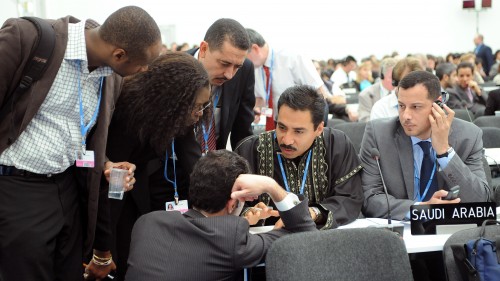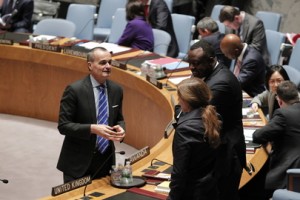As seen in our previous two articles about Formal Debate and Resolution Writing using the UN4MUN procedure, WIMUN’s rules have several points of divergence from the rules of procedure and norms that many delegates may be used to. Though similar to caucusing, Informal Consultations are the biggest change between these two formats because Model UN conferences typically haven’t represented this stage very accurately. At WIMUN, delegates will get a taste of the real process countries go through with their blocs, which includes merging papers and lobbying other countries to support their papers.
Working in Your Groups
Typically at a Model UN conference, you may see groups form seemingly at random during the first unmoderated caucus, with delegates who have worked together before forming blocs or blocs being determined by where delegates are seated in the room. In the United Nations, most legislation originates in the different regional or collaborative blocs of the General Assembly. At WIMUN, delegates will do much of their policy and resolution writing within these blocs. Though there are countless different groups on different issues, there is a core of working groups that is prevalent in almost any GA discussion, including the following:
Asia-Pacific Group: Most of the Asian and Southern Pacific countries, excluding Israel, Turkey, Australia and New Zealand
African Group: All African Countries, including Morocco (which is not a Member State of the African Union)
Eastern European Group: Eastern European Countries (minus Greece), plus Russia
WEOG – The Western European and Other Group: Includes not just Western European countries, but also New Zealand, Australia, Canada, Israel, Greece, Turkey, and the United States (as an observer)
GRULAC – The Group of Latin American Countries: Includes all Caribbean, Central American, and South American states, as well as Mexico
African Union and European Union: Though not formal blocs, these international organizations tend to have their Member States cooperate heavily in the UNGA
NAM – The Non-Aligned Movement: Borne from the Cold War and the increasing polarization of Global Politics, with these countries claiming to be “Non-Aligned,” initially aiming to combat Cold War tensions. Still in existence today, this group is comprised of mainly economically developing countries.
G-77 – The Group of 77: Though originally named for its 77 members, the group today boasts 133 members and is arguably the most affecting voting bloc in the United Nations. It consists of a loose coalition of developing countries seeking joint objectives for economic development and security policy everywhere from the UNGA and UNDP to the IMF.

WIMUN will be a much more negotiation-driven conference than most, so during these initial stages, it may be hard to rectify what you think is a good idea, what your country’s policy is, and what other delegates are saying. Be prepared to make concessions to meet your goal of a consensus on your resolution, as the full endorsement of the United Nations General Assembly will carry a lot of weight for your ideas. Eighty percent of UN resolutions passed are adopted by unanimous consent, so in trying to act as realistic UN delegates, you need to assure that your bloc is unified behind your resolution because you will likely have more policy in common with these countries than any others in the committee.
Merging
While you’re working with your group to form a resolution, many of the other delegates will be as well. Once these initial drafts are formed by each group, it will be important to start merging. Though merging may feel uncomfortable or as if you’re losing your resolution, it is once again important to keep the function of the United Nations in mind: Does any one region or group really know what solutions will be best for the world? By working with other countries toward consensus, you can assure that the needs of all countries are being addressed by your committee’s resolution, not just your own.
Merging is a process of negotiation and concession, and because of this, it is important to go about it in an organized fashion. Find a bloc that has compatible ideas with your own (if you’re in the African Group, maybe you seek out the Asian Group because of the shared interests of economically developing countries), and sit down with a few representatives of each bloc sitting on each side of the table. Then, choose either a member of one of the blocs, or a member of your dais, to sit down and help you moderate your merger. Though you are in informal consultations and do not have to accept any moderation of your discussion, representatives at the United Nations appoint someone to organize discussion for the groups to save time and maintain a professional structure to their negotiations.

If there is opposition, that clause gets marked and set aside for further negotiation, either to find “Compromise Language” (language for the clause that is acceptable to all parties), or to convince one party to drop the clause. These side negotiations should take place between just one representative of each bloc, and these delegates can even move away from the table to allow the rest of their groups to continue merging while they find compromise language. Repeat this process until all of the clauses are accepted, amended, or removed. Then, you have a merged draft resolution with both of your groups on board!
Lobbying
Though countries will mainly work within their blocs, there are issues on which certain countries may differ. Also, though it’s very difficult to merge with more than one resolution at a time, you still want to be in communication with the other groups as you write and merge your resolutions. For both of these purposes, lobbying is a tool that is absolutely vital for delegates to use throughout informal consultations.
Once certain members of your group sit down to conduct a merger, other delegates can go and seek out delegates from other blocs to talk about their resolutions. All delegates lobbying for a group should have a unified message, so they should determine together what ideas and clauses they want to highlight with other groups. These conversations can serve three purposes:
1. To convince delegates that what is in your resolution is agreeable and beneficial to the international community and their group specifically.
2. To hear concerns from other groups about part of their resolution. Eventually, all of the resolutions will hopefully be merged, so if you can anticipate and figure out problems earlier on, it gives you more time to find compromise language and help other groups be more amenable to the clauses in your draft
3. To express apprehensions to other groups about their resolution, and how it may make the merger and negotiation process more difficult when it comes time to work together. Here, you can convince other delegations to adopt compromise language before the actual negotiation process begins.



